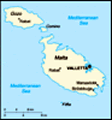Advertisement
Today is Saturday and we went to Mdina and Rabat by way of Valletta. After visiting Valletta on Wednesday, we realised we only had a few shots of the old Royal Opera House. We came to take some shots of the ruins, just inside the city gates before we headed off to Mdina on the bus.
Even this week, there has been a bit of debate in the Times of Malta about the rebuilding of this structure. Very much an ongoing debate here in Malta. The Triton Fountain outside the gates was also working as well.
We finished a few things in Valletta and then headed to Mdina on the bus. On the way we passed an impressive row of arches which we finally realised was an aqueduct built by Grand Master Wignacourt back in the 1600s. This carried water for Valletta from Mdina and is a very impressive piece of work. The total distance of this aqueduct is 16 kilometres.
When travelling towards Mdina you cannot miss the city as it is most prominent on top a hill with the Cathedral of St Paul the most dominant. It is most certainly a very impressive sight.
When
we arrived at Rabat we walked up the hill to Mdina itself to the main gate of the city. There is a bridge across the moat and we decided to get a karozzin (gharry) for a trip around the city of Mdina and Rabat. A karozzin is a horse drawn buggy which can carry 4 passengers. We had a thirty minute trip around which only cost us €35.00. Interestingly, gharry is an Indian word which was used by British citizens in Malta to refer to the karozzin.
This gave us an insight as to what we could see in Mdina so we then set out on foot around this old city. Mdina is extremely old and was settled as long ago as 700BC by the Phoenicians. The current city was established during Norman tiles and the oldest building called Palazzo Santa Sofia dates back to 1233 but with a later addition on top.
We crossed into the city over the bridge and through the main gate. We first visited the Museum of Natural History which is located in the 18th century Palace of Justice. We then went to the tourist information office and got some maps of the
city. It is really small, but lots of little alleys going everywhere. We strolled through the alleys and made our way to the St Pauls Co Cathedral. Once again, the decoration of the interior is just mid blowing. It’s so hard to describe what you are actually seeing and photos just cannot do justice to the art work displayed in these amazing edifices.
We had purchased a multi site pass from Heritage Malta at the Museum of natural History which entitles us to free entrance at all their sites and is valid for a month. There are two other sites in Mdina and Rabat being Domus Romana (Roman House) and St Pauls Catacombs and we then went to visit these two places
We went to Domus Romana where they have excavated the remains of a Roman house which has been dated back to the 1st century BC. The mosaic floors are in remarkable condition considering their age and the pillars have been placed where they would have originally stood. There are fragments of wall plaster but the colours are quite vivid.
After we left here we went and had a coffee in a small workers cafe before
we started heading into Rabat itself. Rabat was built on the outside of the city of Mdina and it means suburb. It existed as part of the Roman city of Melita which was built where Rabat and Mdina now exist. We walked up to the main centre looking for the catacombs but the site of St Pauls Church was just surprising. Completely unexpected after seeing the cathedral in Mdina. They were also preparing for a festa as all the streets and the church were decorated in preparation.
We took a wrong turn so we had a walk around the streets of Rabat but we did eventually find the catacombs. Only problem was they were just closing so we have to come back another day. We then found a gift shop and went and had a look in there. It was interesting that all the streets seemed to have bends in them we learnt a few days later as to why the streets in Rabat wind around corners. The Normans built their streets so that the flight of an arrow was limited to a short distance.
The end of another day with a lot of walking so we headed
back to our villa.
Advertisement
Tot: 0.12s; Tpl: 0.012s; cc: 7; qc: 57; dbt: 0.0723s; 1; m:domysql w:travelblog (10.17.0.13); sld: 1;
; mem: 1.2mb























